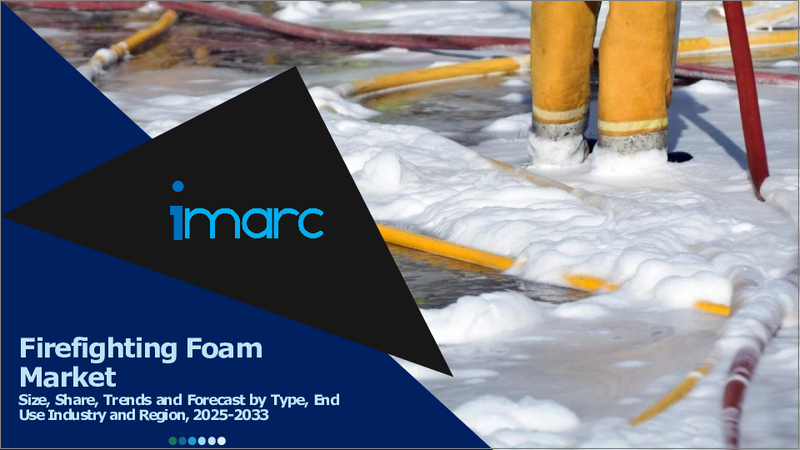|
|
市場調査レポート
商品コード
1820422
泡消火剤の市場規模、シェア、動向、予測:タイプ別、最終用途産業別、地域別、2025年~2033年Firefighting Foam Market Size, Share, Trends and Forecast by Type, End Use Industry and Region, 2025-2033 |
||||||
カスタマイズ可能
|
|||||||
| 泡消火剤の市場規模、シェア、動向、予測:タイプ別、最終用途産業別、地域別、2025年~2033年 |
|
出版日: 2025年09月01日
発行: IMARC
ページ情報: 英文 148 Pages
納期: 2~3営業日
|
概要
泡消火剤の世界市場規模は、2024年に9億7,808万米ドルとなりました。今後、IMARC Groupは、同市場が2033年までに13億9,969万米ドルに達し、2025年から2033年にかけて3.65%のCAGRを示すと予測しています。現在、アジア太平洋地域が市場を独占しており、2024年の市場シェアは38.7%を超えています。同地域では、火災安全に対する個人の意識が高まり、安全規制が厳しくなっていることに加え、消火能力の向上、環境への影響の低減、全体的な効果の向上を目的とした革新的な発泡技術の開発が進んでいるため、市場が拡大しています。
泡消火剤市場の主な促進要因の1つは、産業・商業分野における火災安全への関心の高まりによる高度な消火ソリューションへの需要の増加です。石油・ガス、航空、化学などの産業が拡大を続ける中、大規模火災のリスクが高まり、効果的な消火システムの需要が高まっています。このため、より迅速な消火と高い消火効率を実現する特殊な泡消火剤の採用が進んでいます。さらに、世界的に規制と安全基準が厳しくなっているため、組織は高品質の消火用フォームに投資するようになり、市場の成長に拍車をかけています。
米国は、大規模な消火能力を必要とする大規模な産業、軍事、航空セクターがあるため、泡消火剤市場で85.80%の市場シェアを占め、支配的な役割を果たしています。例えば、パーフルオロアルキル物質やポリフルオロアルキル物質(PFAS)を含む消火用フォームの主要な消費者であった米国軍は、環境問題への懸念や、2023年までにPFASを含まないフォームを義務付ける国防権限法(2020年)などの厳しい規制要件のために、PFASを含まない代替品への移行を開始しています。その課題には、効果的なドロップイン代替品がないことや、21億米ドルを超える移行コストの見積もりなどがあります。さらに、環境保護庁(EPA)のような米国の規制機関は、泡消火剤市場を形成する基準を設定する上で極めて重要であり、特に有害物質の排除を推進していることが市場成長を促しています。
泡消火剤市場の動向:
厳しい安全規制
各国の行政機関は、厳しい安全規制を実施することで消火フォームの採用を奨励しており、これが市場の成長を後押ししています。これに伴い、石油化学、製造、航空など様々なセクターが厳しい火災安全基準やガイドラインを遵守しています。これらの規制は、火災抑制能力を強化し、人命と資産を保護するために、高度な泡消火剤システムの使用を義務付けています。さらに、可燃性液体火災のリスクが高い石油・ガス業界では、泡消火剤ソリューションの導入が増加しており、市場の成長を後押ししています。例えば、米国防火協会(NFPA)によると、2022年の米国における泡消火剤システムの設置件数は5,000件を超えており、特に石油・ガス業界では火災抑制が重要な要件となっています。これとは別に、石油・ガス会社は貯蔵タンクに固定式泡システムを採用し、処理施設には泡消火装置を採用しています。さらに、コンプライアンス違反は厳しい罰則の対象となり、大惨事となる火災に対する脆弱性が増大する可能性があります。さらに、このような安全規制は、新たなリスクに対処するために進化することが多いです。泡消火剤の市場予測によると、複数の産業でより高い効果を提供する先進的な泡消火剤技術に対する需要の高まりが、今後数年間の市場拡大に大きく貢献すると予想されています。
技術の進歩
泡消火剤と泡消火システムの技術進歩が市場の成長を後押しします。この点で、主な企業は、消火能力を強化するとともに、環境への影響を低減し、あらゆる面で効果を発揮することを目的とした新しい泡技術を開発しています。さらに、従来の発泡剤には、環境に甚大な害をもたらすパーフルオロアルキル物質やポリフルオロアルキル物質PFASが含まれていました。さらに、従来の発泡体には、環境に対して甚大な害を及ぼすパーフルオロアルキル物質(PFAS)とポリフルオロアルキル物質(PFAS)が含まれていました。ある産業レポートによれば、2001年から2023年にかけて、森林火災の影響を受ける世界の面積は毎年約5.4%増加しています。これはクロアチアの面積に匹敵します。メーカー各社は、厳しい環境規制を満たす生分解性で有害性の低い発泡ソリューションを導入しています。組織が持続可能な消火オプションを求めるようになってきているため、こうした環境に優しいフォームが人気を集めています。このほか、泡の膨張率と安定性の進歩により、泡消火剤は可燃性液体火災を含むさまざまな種類の火災をより効率的に消火できるようになっています。さらに、泡の放出システムはより精密になり、最適な消火範囲と消火制御を実現しています。これとは別に、遠隔監視や自動泡放射システムなどのデジタル技術の統合により、泡消火剤の使いやすさと有効性がさらに向上しています。
石油・ガスセクターで高まる火災リスク
2024年、インディアン・オイル・コーポレーションのマトゥーラ製油所で火災が発生し、従業員8人が負傷しました。石油・ガスセクターにおける火災関連事故の増加は、泡消火剤市場の需要を牽引する重要な要因です。この分野では、原油、天然ガス、石油化学製品などの可燃性物質が使用されるため、火災や爆発のリスクが高いです。泡消火剤は、酸素供給を抑制し、火災を冷却するバリアを形成することにより、このような火災の制御と消火に重要な役割を果たしています。石油・ガス業界では、厳しい安全規制や操業上の危険性を最小限に抑えることへの関心が高まる中、先進的な消火ソリューションの導入が進んでいます。さらに、世界的な石油探査・生産活動の拡大が、泡消火剤の需要をさらに増大させています。フッ素フリーフォームや耐アルコールフォームなどの特殊フォームの開発は、業界特有の要件に対応し、安全対策をサポートし、市場の成長に寄与しています。
目次
第1章 序文
第2章 調査範囲と調査手法
- 調査の目的
- ステークホルダー
- データソース
- 一次情報
- 二次情報
- 市場推定
- ボトムアップアプローチ
- トップダウンアプローチ
- 調査手法
第3章 エグゼクティブサマリー
第4章 イントロダクション
第5章 世界の泡消火剤市場
- 市場概要
- 市場実績
- COVID-19の影響
- 市場予測
第6章 市場内訳:タイプ別
- 水性フィルム形成フォーム(AFFF)
- 耐アルコール性水性フィルム形成フォーム(AR-AFFF)
- プロテインフォーム
- 合成洗剤フォーム(高発泡・中発泡)
- その他
第7章 市場内訳:最終用途産業別
- 石油・ガス
- 航空
- 海洋
- 鉱業
- その他
第8章 市場内訳:地域別
- 北米
- 米国
- カナダ
- アジア太平洋
- 中国
- 日本
- インド
- 韓国
- オーストラリア
- インドネシア
- その他
- 欧州
- ドイツ
- フランス
- 英国
- イタリア
- スペイン
- ロシア
- その他
- ラテンアメリカ
- ブラジル
- メキシコ
- その他
- 中東・アフリカ
第9章 SWOT分析
第10章 バリューチェーン分析
第11章 ポーターのファイブフォース分析
第12章 価格分析
第13章 競合情勢
- 市場構造
- 主要企業
- 主要企業のプロファイル
- Angus Fire Limited
- Dafo Fomtec Ab
- DIC Corporation
- Eau&Feu
- Fabrik chemischer Praparate von Dr.Richard Sthamer GmbH & Co. KG
- Johnson Controls International Plc
- Kerr Fire(Kidde plc)
- KV Fire Chemicals Pvt. Ltd.
- National Foam Inc.
- Perimeter Solutions
- SFFECO Global





